Are your homegrown carrots forked, branching, twisted, or knobby? While they may make for amusing photos, these deformed vegetables can make food preparation a challenge – try turning a twisted carrot into carrot sticks!
These odd-shaped vegetables can also be a sign of serious garden problems. But what causes these deformed veggies?
There are many different factors that can cause twisted, forked, and asymmetrical roots – ranging from how you prepare your soil to nasty garden pests, and including several other unfavorable conditions.

We link to vendors to help you find relevant products. If you buy from one of our links, we may earn a commission.
While you can’t straighten a carrot out once it gets wonky, you can learn how to prevent deformities and produce a nice straight root crop in your next growing season.
I’m going to cover nine causes for deformed carrot roots – and ways you can prevent them. Here’s what’s ahead:
What You’ll Learn
Are Deformed Carrots Edible?
Before we get to our main purpose, let’s get the question of edibility out of the way, because I’m guessing this question is going to pop into your head at some point before we get to the end of the article if it hasn’t already.
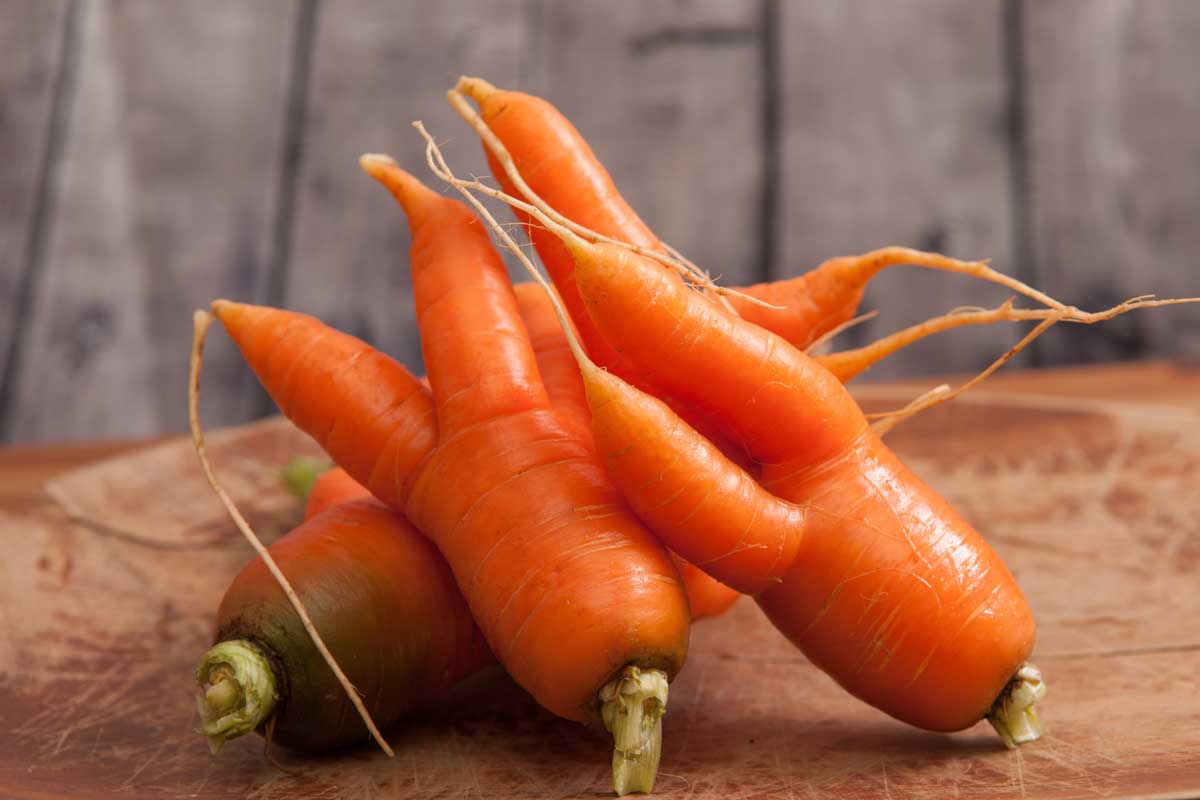
In most cases, yes, your wacky looking carrot roots are edible. There are a few exceptions, however, and I’ll let you know about them along the way.
While the less than perfect looking roots are excellent for chopping and adding to soups or stews, there’s something satisfying about harvesting a crop that looks just like what’s pictured on your seed packet.
As long as they’re otherwise healthy, don’t let those more unusual specimens go to waste! Just follow our tips to plan ahead for next year if more uniform roots are what you’re after.
Soil Preparation
As a carrot root grows, it is highly sensitive to soil conditions.
Its growing tip will detect any obstacle it encounters and change its path accordingly. If a carrot could talk, it might say something like this:
“Rock? Must be going the wrong way. Clod? Time to change directions. Hard soil? Hmm, maybe I’ll make a U-turn…”
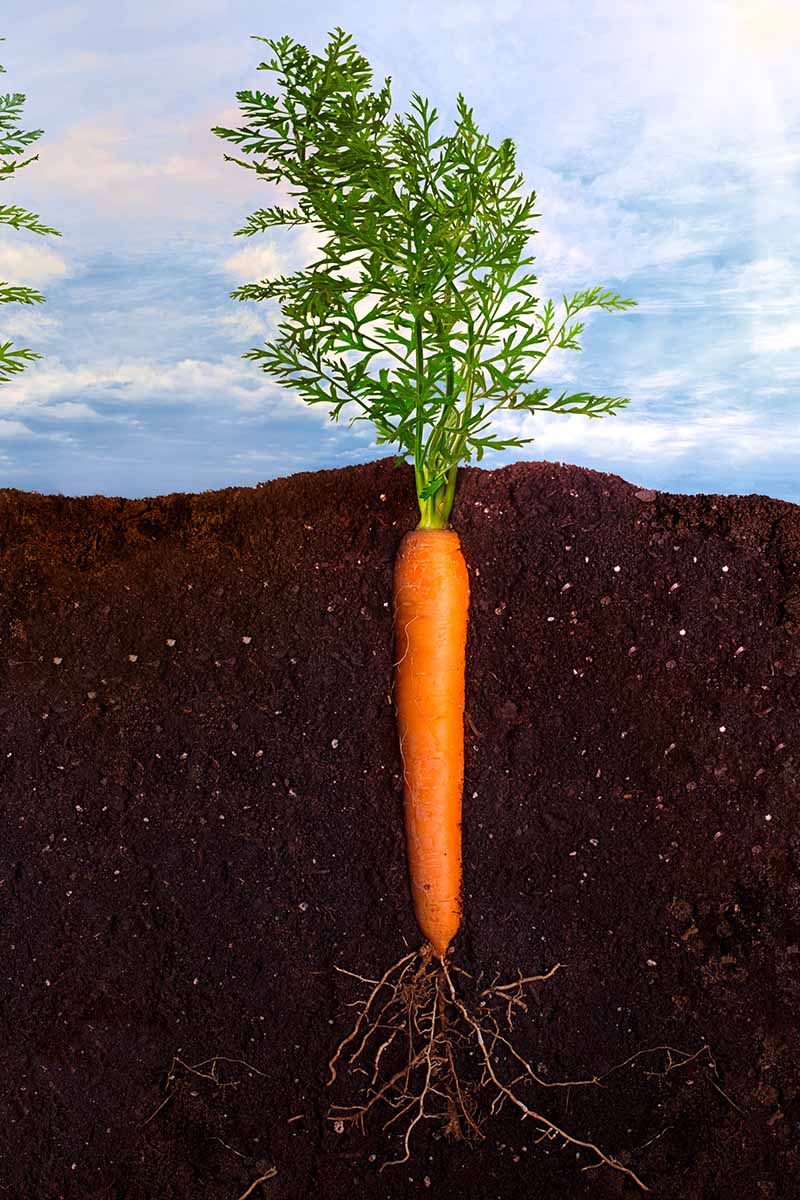
These veggies are also very sensitive to nitrogen and react to this macronutrient in ways that won’t please most gardeners.
So, to give your crop the best start, you’ll need to begin with your soil.
Heavy Soil
If you begin with compacted or heavy clay soils, you’ll celebrate your fall harvest with a small crop of short, stumpy carrot roots.
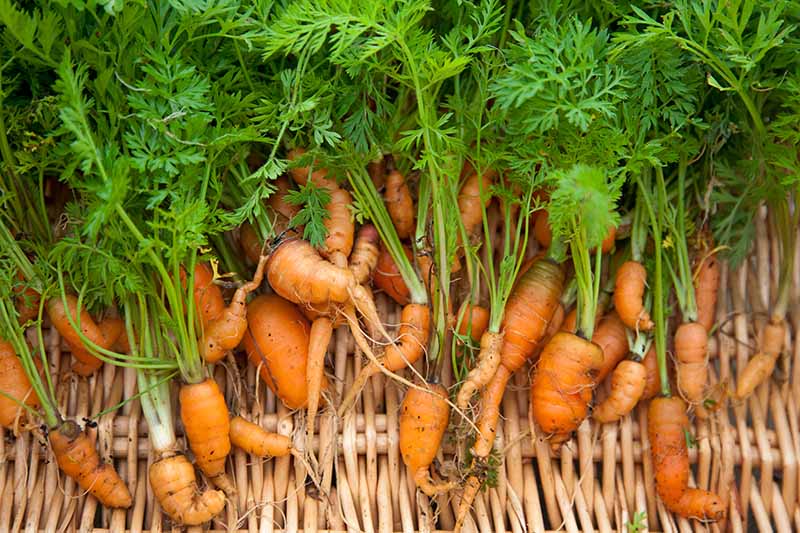
J. Lipiec, V. V. Mendvedev, et al, the authors of an article in International Agrophysics published in 2003, describe soil compaction, primarily caused by the use of heavy machinery, as producing smaller yields of carrots with a high proportion of stunted and deformed roots.
And soil compaction can happen no matter what type of soil you have.
To keep your soil loose, avoid walking on your planting rows or beds. Instead, walk only between rows or around beds.
You might also want to consider no-till gardening, which doesn’t introduce heavy machinery into your growing space.
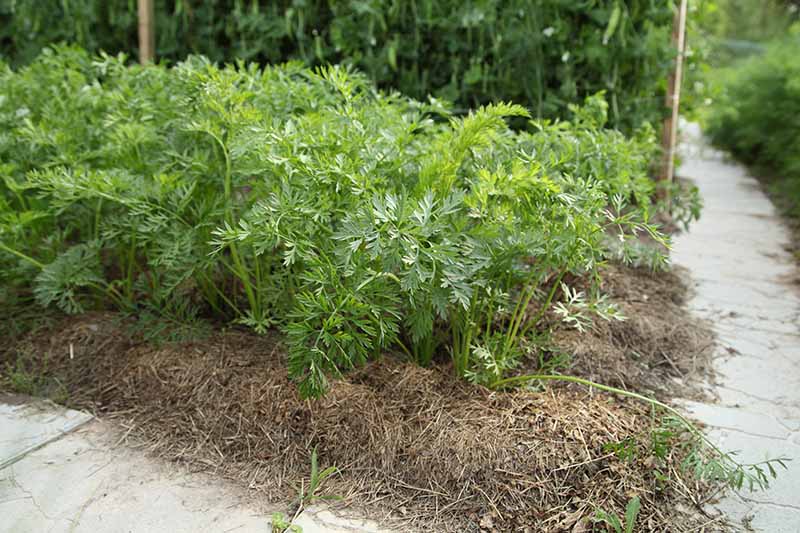
Also, certain types of soil are better than others for growing carrots. According to Jill MacKenzie at the University of Minnesota Extension, the best soil for this purpose is sandy loam.
If you’re starting off with compacted and/or heavy clay soil, improve it by working some compost and sand into it before you plant.

You’ll need your soil to be loose to the same depth as the mature carrots you intend to grow. If you are growing 12-inch roots, you’ll need 12 inches of loose soil.
And if you’re not sure what kind of soil you have, consider doing a soil test.

Another solution when planting in heavy clay soils is to simply choose a more suitable carrot variety.
If you have clay soil, grow shorter, blunt-tipped varieties for the best success, such as the ‘Little Fingers’ cultivar.
Seeds are available from True Leaf Market.
Rocks and Clods
Rocks and clods of dirt in the soil can also be problematic, causing carrot roots to grow crooked or to branch.
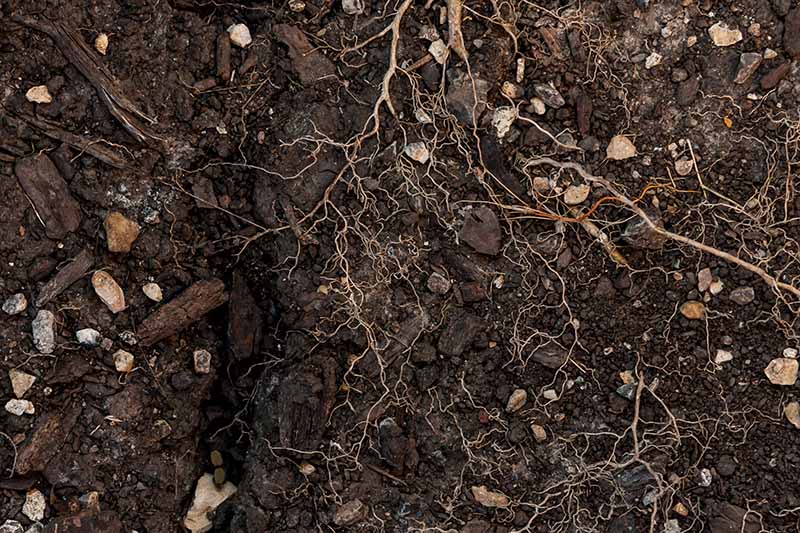
When you prepare your beds for planting, sift through your soil and remove any rocks, clods, sticks, or large pieces of organic matter that have not broken down.
Are you planting varieties that can grow 12 inches long? Then you will need to do this to a depth of 12 inches.
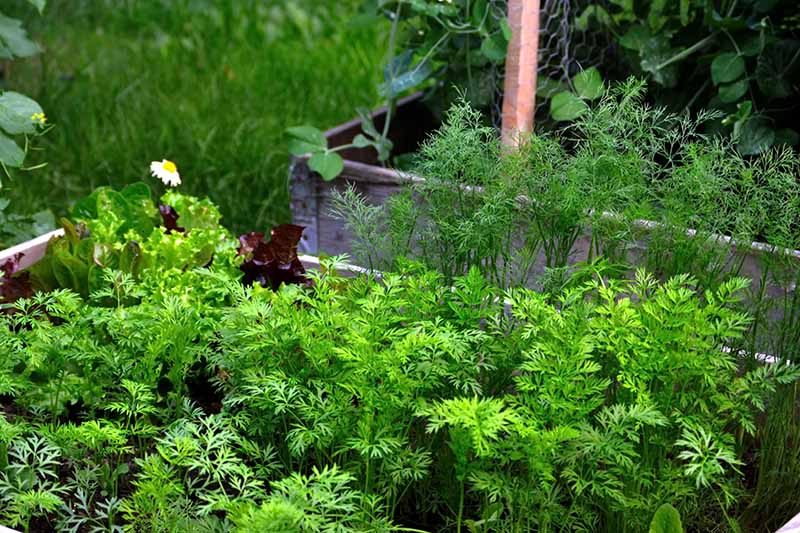
If your soil is simply too rocky, grow these veggies in raised beds prepared with bagged garden soil with sand mixed into it instead.
Too Much Nitrogen
Many of your garden plants need lots of nitrogen while they are growing. But this is not so with carrots.
In a study conducted by M. Moniruzzaman and other members of the Department of Agriculture at Sher-e-Bangla Agricultural University and published in The Agriculturists in 2013, the authors describe an experiment on the effects of nitrogen applications and branching in carrot crops.
Wonder what they found? The highest dose of nitrogen resulted in the most branching, and no dose of nitrogen resulted in the least amount of branching.
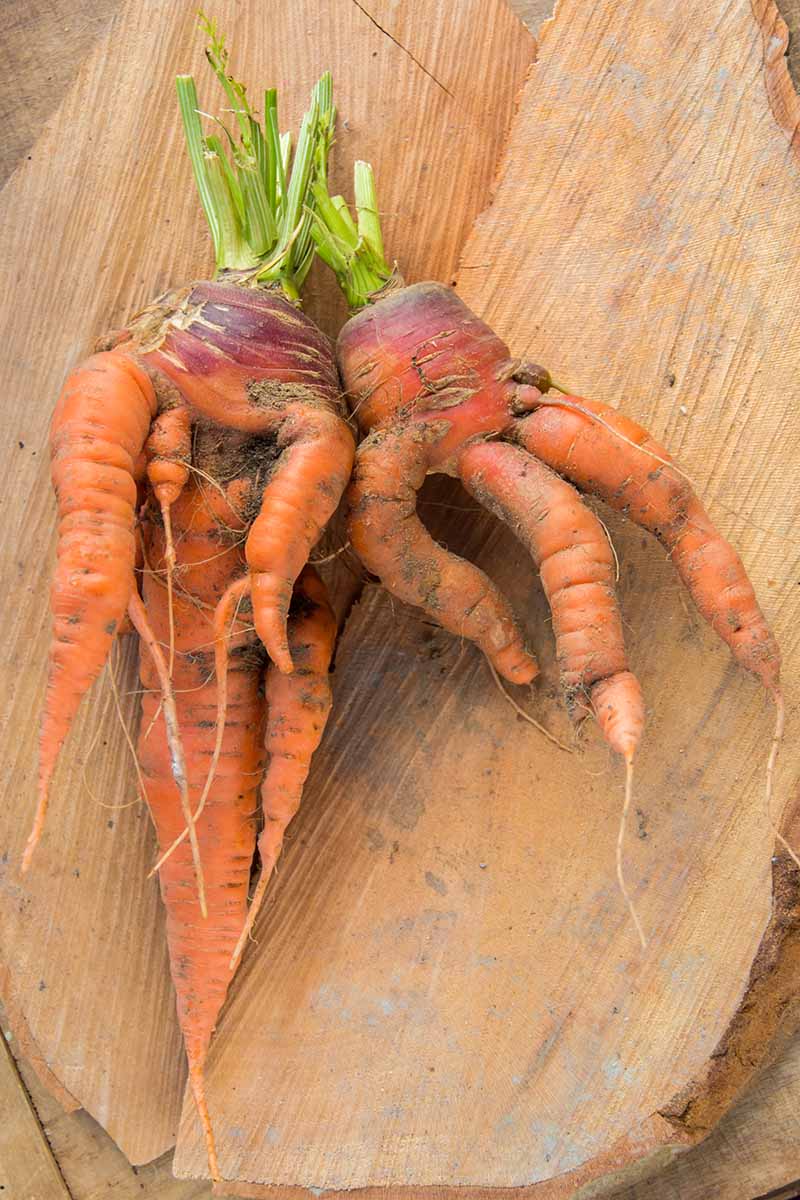
This means that when using manure to fertilize this crop, make sure to only use well-aged manure. Fresh manure contains more nitrogen – promoting branching, forking, and hairy roots.
If you tend to use commercial fertilizer, work a balanced fertilizer (5-10-10) into the soil prior to planting seeds.
A lower ratio of nitrogen (N) to phosphorus (P) and potassium (K) is recommended for growing root vegetables, fruits, and flowers, versus leafy greens and ornamentals that require more nitrogen to put into leaf production.
But before you fertilize, why not test your soil? This way you’ll be sure of what your soil is offering your crop in terms of nitrogen (which these veggies don’t need much of) and phosphorus (which they do).
Growing Care
Your preventive measures don’t stop with soil prep.
While your crop is growing, there are a few ways you can keep your carrot roots on the straight and narrow, including making sure they have the space they need.
Dense Plantings
This brings us to another cause of odd-shaped carrot roots: growing plants together too densely.
F. K. Appiah, J. Sarkodie-Addo, and A. Opoku, the authors of an article published in the Journal of Biology, Agriculture and Healthcare in 2017, found a clear relationship between plant density and number of deformed roots – the higher the density, the more deformities they found.
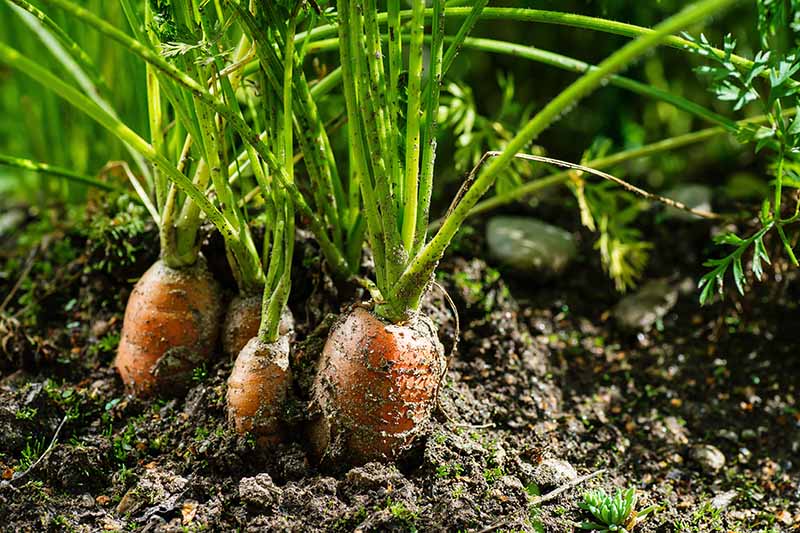
Carrot seeds are typically sown heavily, because of their typically low and slow germination rates.
To prevent twisty-turny veggies, seedlings will need to be thinned when they are 3-4 inches tall.
Otherwise, they will end up twisting around each other and forking rather than growing straight. To learn how to thin your carrot seedlings, refer to our growing guide.
Weeds
Just as close proximity to other carrots can cause twisting and branching, weeds have underground roots that can get in the way of growth as well, and they will also compete for nutrients.
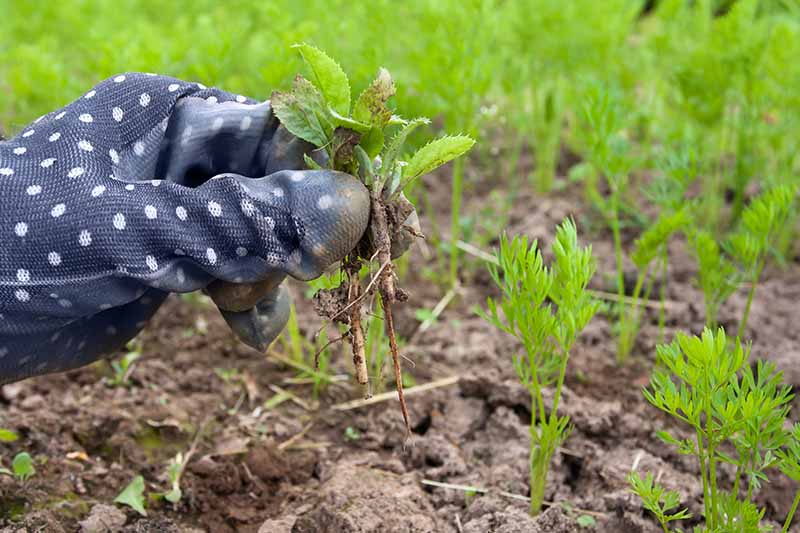
Make sure to keep your beds weeded throughout the growing season, so that weeds don’t interfere with your root crop.
Transplanting
Let’s say you’ve started growing a bunch of carrots in a container – which is a valid option if you do it right.
Once they begin to take off in Potville or Planterland, you’re not going to want to transplant them to Gardenbedia.
Why? You guessed it: the roots will fork.
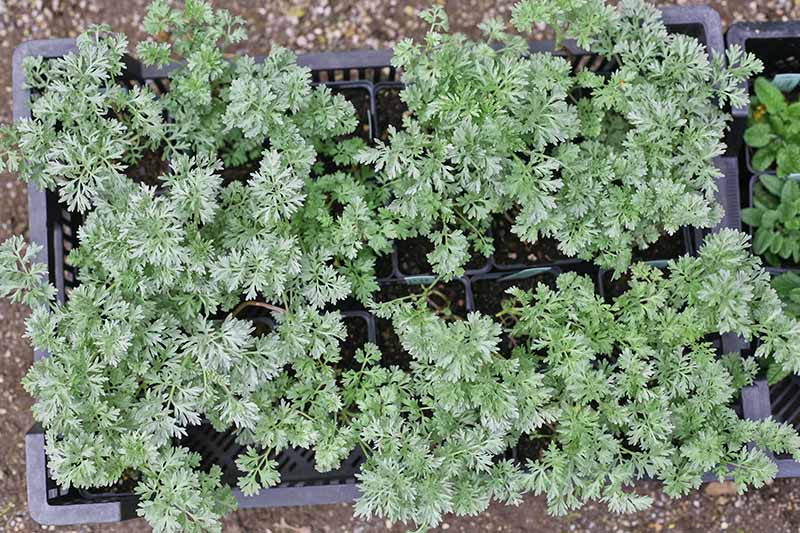
This is due to the fact that these plants are highly sensitive to disturbance.
So far you’ve learned that they don’t like rocks, they don’t like clods, they don’t like too much nitrogen, they don’t like weeds, and they don’t like sharing their space.
Well, they don’t like to be transplanted either, which is why they are usually sown directly in the garden.
When you sow your seeds, choose a location or container where you can let them keep growing in the same spot until they’re ready to harvest.
In USDA Hardiness Zones 1-2, where the growing season may not be long enough to grow carrots from seed outdoors, consider starting seedlings in biodegradable pots that can be carefully planted directly in your garden soil.
Second Growing Season
There’s another cause of branching carrot roots that might not occur to you at first thought.
These plants are biennials, similar to a variety of other edible crops including kale, meaning their growth will continue through two seasons. So, is your crop in its first year, or its second year of growth?
If your plants have already gone through their first growing season, followed by overwintering in the ground, and are starting a second growing season, they are now in seed-making mode.
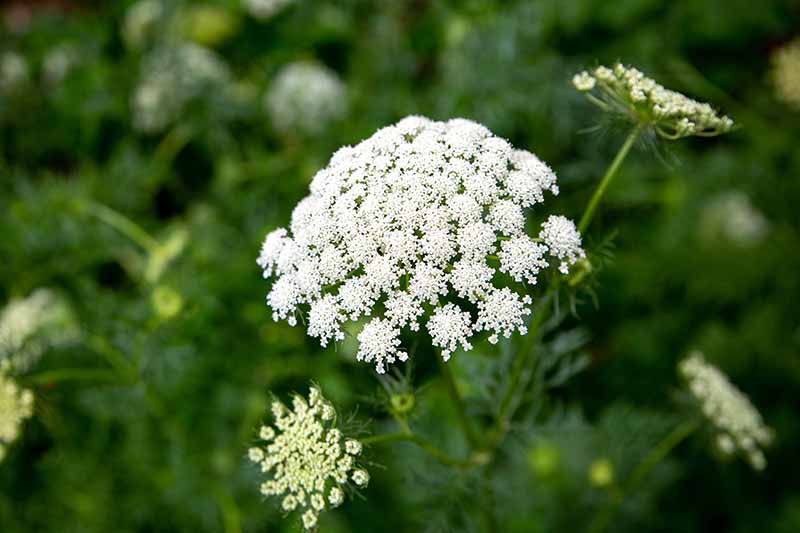
During their second growing season, as they flower and begin to produce seed, they may put out secondary roots from the taproot (the part we like to eat), changing your long cylindrical root into a branched oddity.
The solution to this one? Harvest your carrot crop before it starts its second growing season.
Unless you are saving part of your crop for seed, you will want to harvest before your carrots begin their second growing season anyway.
These plants will move their energy into flower and seed production, and the roots will become pithy and less tasty than they would have been if picked earlier.
You may also wait to harvest your crop until after autumn’s cooler temps have a chance to sweeten your roots, or at the end of winter, but keep an eye on the weather and be sure to pick them before spring spurs new above-ground growth if you go with this option.
If flower production has already begun, this is case number one where you will want to forego eating your deformed carrots.
Consider allowing them to continue their growth cycle and collect seeds from pollinated plants for planting next season instead of enjoying the vegetable roots in your cooking.
Pests and Disease
I’ve covered several common and fairly easy ways to keep these root veggies straight and get them off to a good start. Now, here comes the trickier part: battling with the less easily controlled forces of carrot pests and disease.
Root-Knot Nematodes
Would you have ever imagined that microscopic worms could cause your carrots to branch? While it’s not a pretty picture to bring to mind, they can and they do.
Luckily these worms, called root-knot nematodes (Meloidogyne spp.), also make their presence known through small galls or knots on the roots. I say luckily, because if you have a problem with these pests, this sign will help you to correctly identify them.
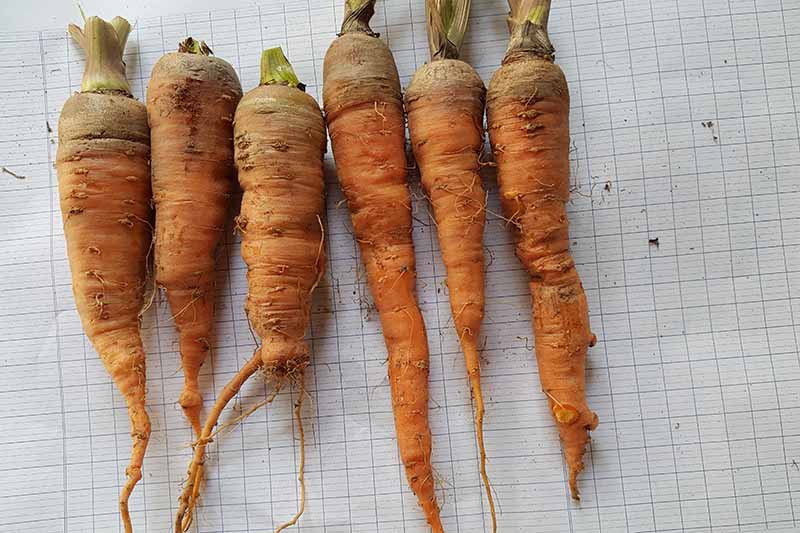
Though infected plant tops often look wilted or stunted, sometimes the symptoms of this pest are totally invisible above ground.
You may not know you have a root-knot nematode problem until harvest time, when you discover what’s been hiding underground – knobby, hairy, deformed roots.
Root-knot nematodes are plant parasites that feed on root tissue, and they are more commonly found in sandy soils – just the place where carrots like to grow.

Once nematodes have infested carrot roots, there is no treatment except to remove infected plants. The best remedy will be preventing these pests from attacking your next crop.
In the meantime, if you find yourself with these pests in your garden, here are a few ways to stop them from setting up camp permanently:
- Remove all infected plant material. Start by removing and throwing away all infected plants and debris – don’t compost it. You don’t want to take any chances with these pests spreading to the rest of your garden.
- Don’t spread infected soil. Be careful not to inadvertently spread soil from an infected area to other areas of the garden via tools or equipment. Make sure to clean these after using them in infected areas.
- Harvest your spring crop early. Root-knot nematodes are most active at temperatures over 70°F, and inactive below 60°F, so harvesting their food source early will keep populations low and prevent a population explosion.
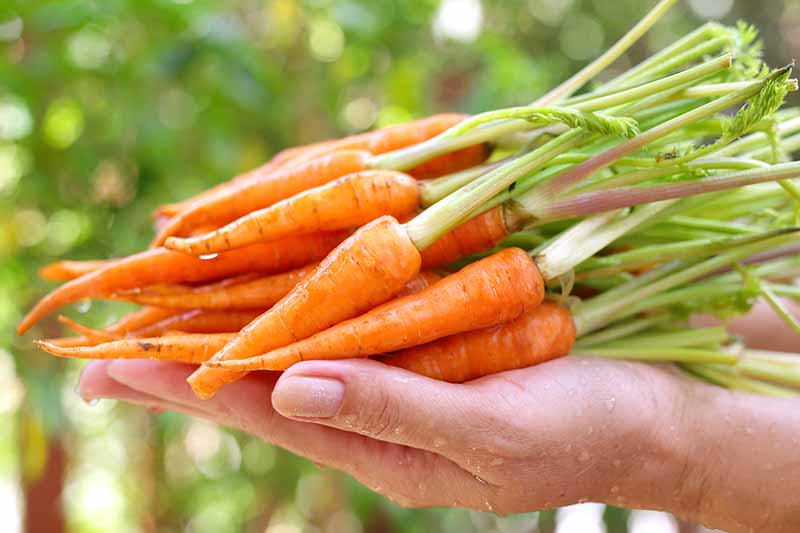
- Rotate the infected area with non-host plants. Root-knot nematodes will only live in your garden as long as they have something to eat. Unfortunately, most of your garden crops are on their menu. What they can’t eat are plants in the cabbage family (kale, broccoli, collards, cauliflower, mustard), grass family (wheat, rye, oats, millet, sorghum), hairy vetch, and asparagus.
- Interplant and/or rotate with marigolds. Marigolds keep nematode populations in check, which is one reason I always grow these beneficial companion plants throughout my garden. After a nematode infestation, put in an uninterrupted planting of marigolds in the infected area. Space the plants no more than seven inches apart.
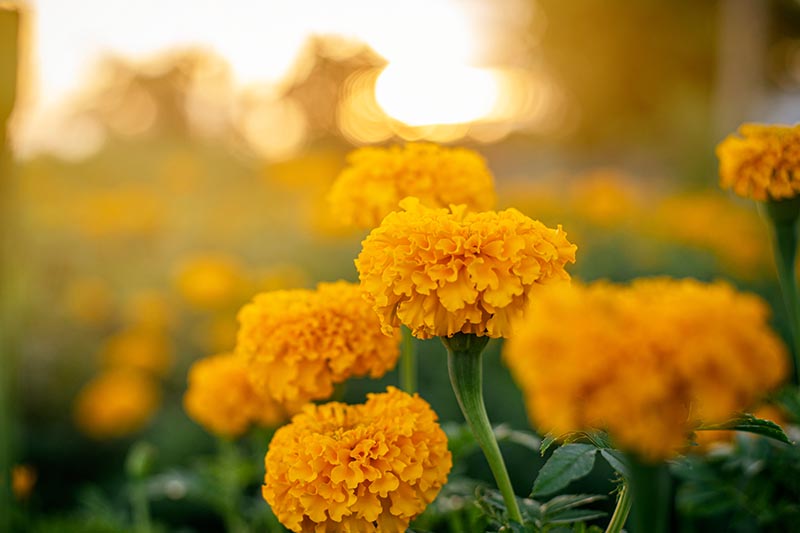
- Add organic matter. Adding compost to the infected area can help increase beneficial microorganisms and lower root-knot nematode populations.
- Till your garden. Tilling will bring root-knot nematodes to the surface, where they will be more readily exposed to weather extremes and die. On the other hand, this may also destroy and disturb beneficial organisms (and cause soil compaction and forked roots as mentioned above), so reserve this option as a last line of defense.
Now, if you’re wondering whether you can eat crops damaged by these pests, rest assured that root-knot nematodes are plant parasites that don’t target humans.
However, these pests can cause damage so severe that the best place for a badly infected crop will be the trash bin.
In the case of less affected crops, remove all galls and damaged areas, and as an extra measure of hygiene, cook the carrots well – temperatures of 140°F will kill the pests.
Aster Yellows Phytoplasma
If you think the root-knot nematode sounds pretty bad, brace yourself, because it’s about to get a lot worse.
Another cause of hairy, distorted roots in this garden vegetable is a disease spread by the aster leafhopper (Macrosteles quadrilineatus).
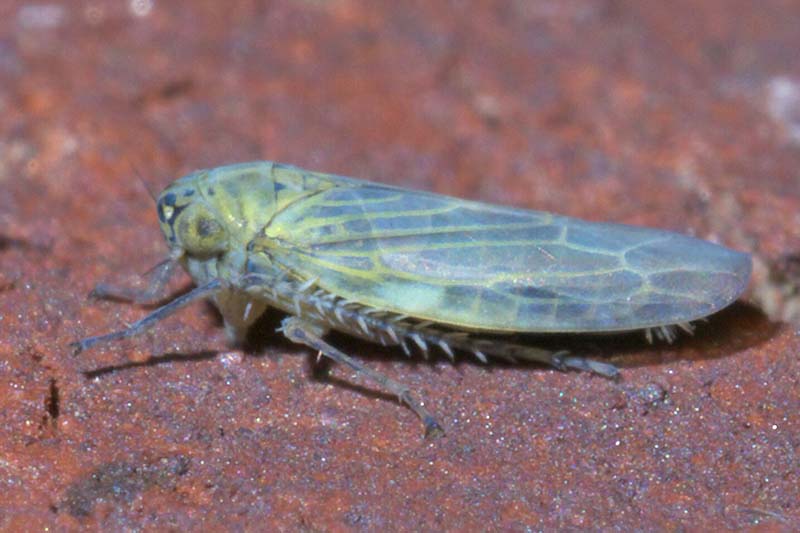
This unwitting insect feeds on a wide variety of plants, sucking sap here and there.
And if it happens to eat from a plant infected with the aster yellows phytoplasma, it will transmit this disease to each plant it puts its mouth on.
The list of other plants susceptible to this disease is too long to cite here, but includes a huge number of edibles and ornamentals.
Aster yellows phytoplasma is harbored by broadleaf weeds such as dandelion and plantain – so one means of prevention is to keep your garden and surrounding area clear of these weeds.

Cool, wet summers offer the most favorable conditions for both the aster leafhopper and the phytoplasma, so keep a lookout for symptoms in carrot leaves during periods of summer with this type of weather in particular.
Along with deformed roots, some of the other symptoms of this disease are pale, yellow leaves with green veins, curling foliage, and deformed flowers.
One way to keep aster leafhoppers away from your crops is to mulch with aluminum foil or oat straw, which will reflect sunlight more than your garden soil, dissuading these bugs from visiting your plants.
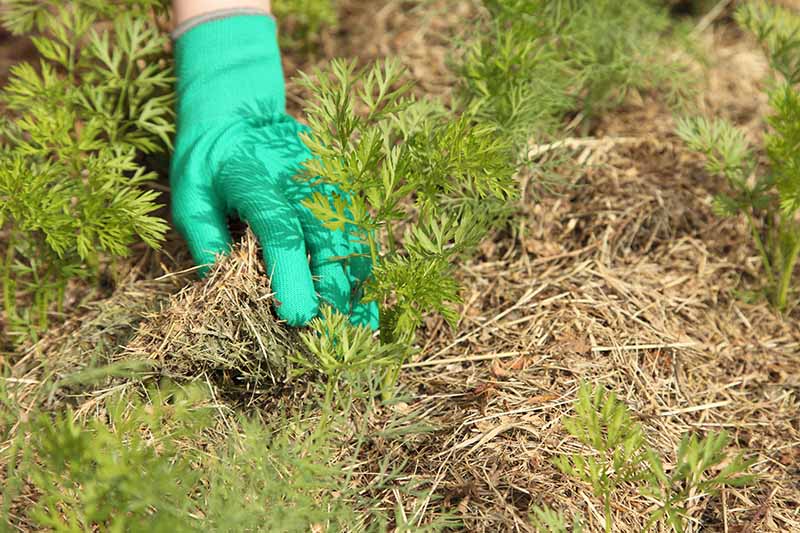
You can also grow your crop under row covers to keep leafhoppers away.
Once you have diagnosed a problem with this disease, remove affected plants immediately (including any other infected ornamentals or garden veggies) and dispose of them in the trash.
Carrot roots affected by this disease will become bitter, so don’t bother trying to eat them.
Quick Guide to Preventing and Identifying Causes
| Cause | Symptoms | Preventive Measures |
|---|---|---|
| Compacted, heavy soil | Short, stumpy roots | Work sand and well-aged compost into soil |
| Rocks, clods, other objects in soil | Forked, deformed roots | Remove rocks, clods and other objects from soil |
| Too much nitrogen | Hairy roots, with forking or branching | Add little or no additional nitrogen to soil |
| Dense plantings | Twisting, forking | Thin when seedlings are 3-4″ tall |
| Weeds | Branching, forking | Keep beds weeded |
| Root knot nematodes | Galls, forking, hairy roots | Dispose of infected plant waste, rotate, don’t grow summer crop |
| Aster yellows | Deformed hairy roots, yellowing leaves, curling foliage, deformed flowers | Remove infected plants and weeds, apply reflective mulch, remove host weeds |
| Transplanting | Forking, branching | Don’t transplant, start seeds in ground or permanent pots |
| Second growing season | Forking, branching | Harvest in first year |
Recipe Ideas for Enjoying Deformed Carrots
If you’ve already got a harvest of otherwise healthy forked or twisted carrots on hand, why not go ahead and use them in the kitchen?
There are endless ways you can sneak these goofy garden veggies into your culinary creations – and nobody will know the difference.
If you chop, shred, dice, or puree your wacky roots, they will be transformed into just another ingredient, with that sweet flavor that you crave.
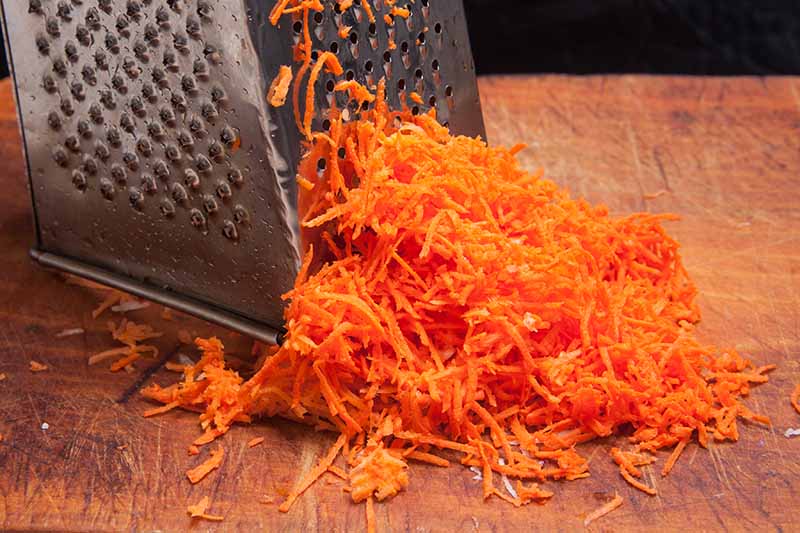
I love throwing carrots into homemade soups. In this recipe from our sister site Foodal for potage parmentier, or potato leek soup with added tasty roots, you can puree your twisty veggies into a warming winter meal.
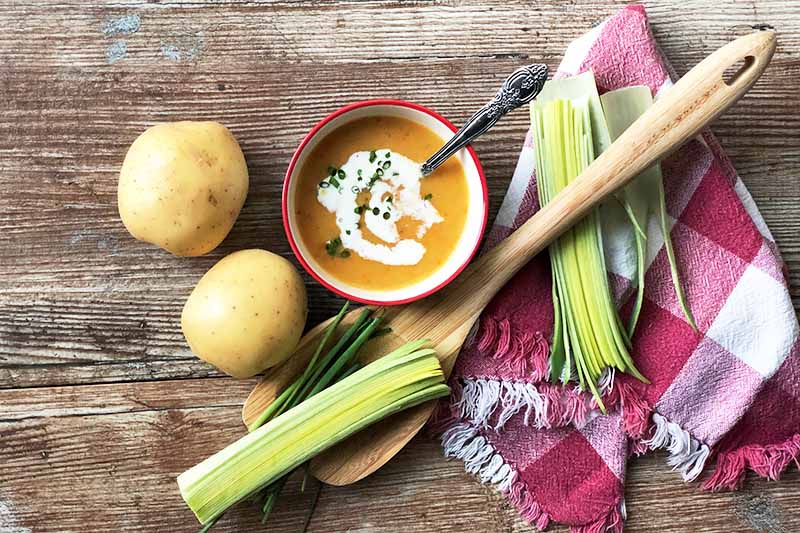
Or if you’re in the mood for something more substantial, chop them up and roast them with other root veggies to accompany this maple glazed pork roast.
You’ll find tips for making this one at home over on Foodal as well.
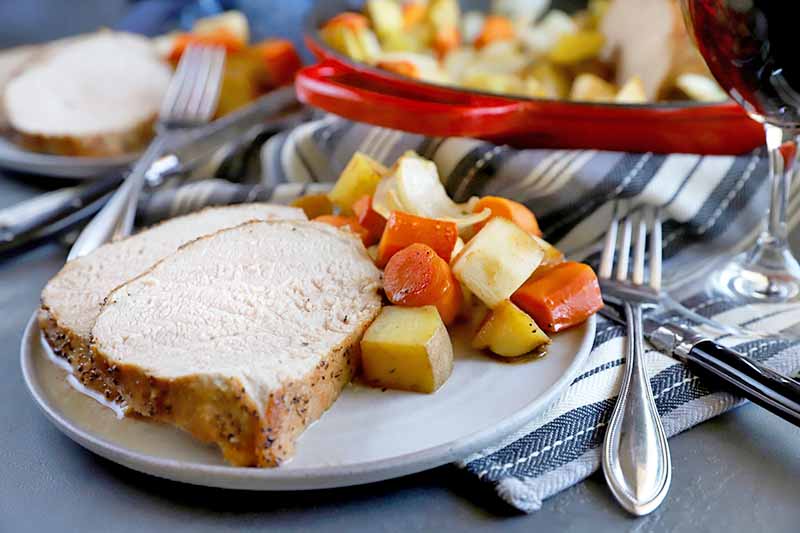
And don’t forget dessert!
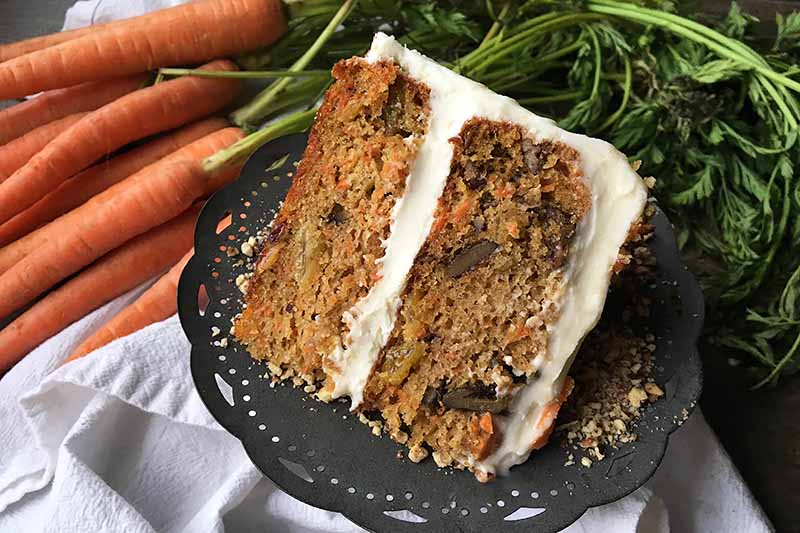
Shredded, your weird-looking roots will melt in your mouth in this carrot cake with cream cheese frosting. Get the recipe now on Foodal.
We’re Straight Rooting for You
You should be well-equipped now to grow your next batch of carrots without the twisting, branching, or forking you may have seen in the past.
Remember to prepare your soil properly, don’t let your beds get too crowded, and keep an eye out for signs of pests and disease.
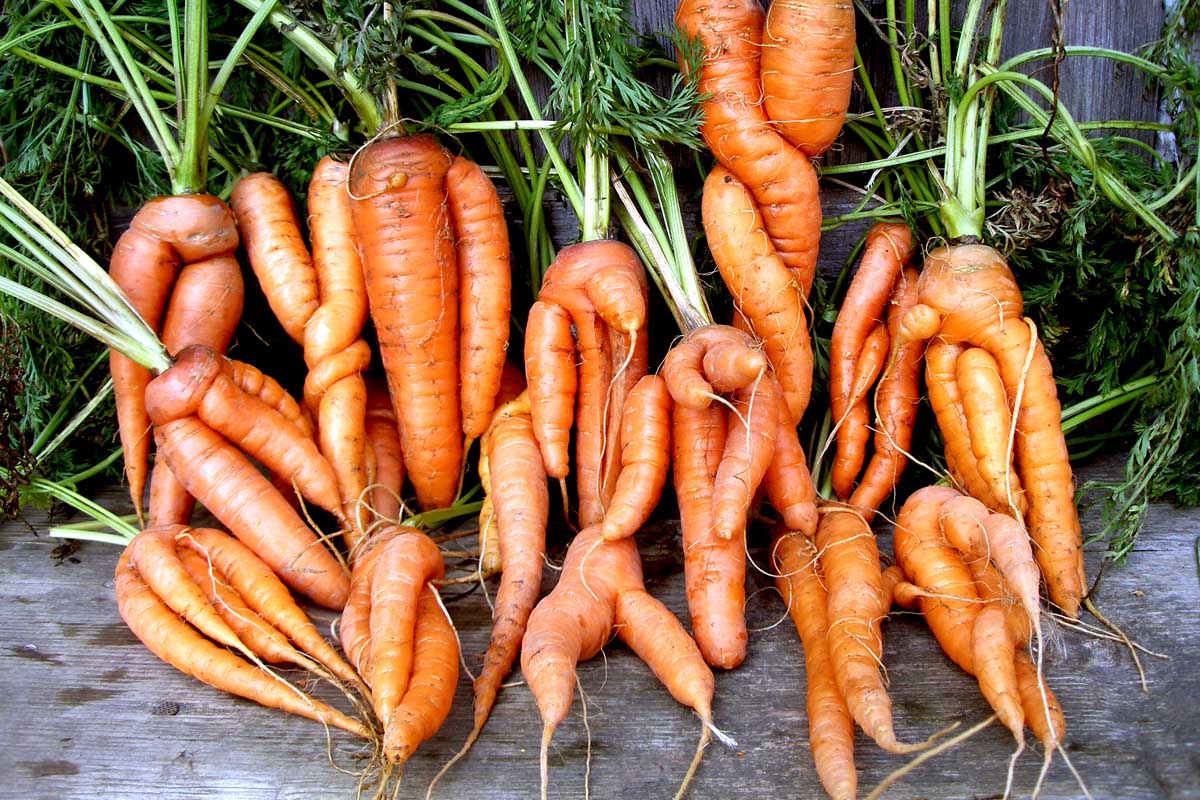
If you follow these tips, your next crop of long orange roots should be easy to carve into delicious, homegrown, straight carrot sticks.
Have you had issues with deformed crops? After reading this article, what do you think the cause was? Let us know in the comments.
And learn more about growing growing carrots right here:


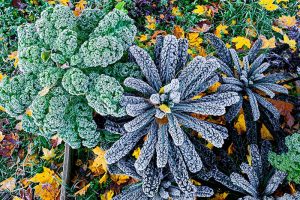


3 things I did wrong I transplanted them used high N fertilizer and did not add enough sand and did not soil condition deep enough. Thanks I will now try again next year
Glad the article helped, Mark! Best of luck with your next crop of carrots!
Thanks for a great article!! I believe my carrots problem is soil with too much biggish organic material. I didn’t sift the ground first and I also always start out in a container and then transplant! Poor babies were being put through lot of stress!!! At least they are very sweet and delicious, if funny looking!!
Hi Celeste! Glad you enjoyed the article! Thanks for sharing photos of your carrots! While twisty, turny carrots aren’t the easiest to work with in the kitchen, they can definitely provide some comic relief! ????
What is the cause for this deformity in carrots?
Can you share photos and describe the problem, Rishikesh?
This splitting only occurs on about 1 in 10 carrot roots in my raised bed. Can you help me identify the cause and suggest a way to correct it?
Hi Edie, Usually what causes carrots to crack is a fluctuation in watering, specifically a period of low water followed by a period of very high water. One thing you can do to remedy this is to work organic matter into your soil, which will help the soil retain moisture, and hopefully, prevent the carrots from drying out quite so much between waterings. It can also help to reduce the amount of water you provide when carrots are about 3/4 of the way to full size. While water issues are usually the main reason for splitting, too much nitrogen can… Read more »
Excellent article on wonky carrot OUTSIDES, but what about REALLY wonky innards? I went for a yellow/orange/purple(black) mix this year, in pelleted seed tapes to avoid the waste & time of thinning, planted in a virgin 12″ raised bed. Worked great, lots of beauties. But then we got this thing, that looked like a possessed carrot in need of an exorcism, looked turned inside-out & like the back/butt/legs of a human. What is going on? This was NOT cut, pic is as it came out of the ground (but washed off)
Hi Susan, Your weird looking carrot looks like a lot of other strange ones I’ve seen. They tend to take on the look of human body parts! If you only had one weird carrot out of the bunch, I’d say you were doing things correctly. As an aside, I have been reading recently about microplastics causing deformation in carrot roots, which makes it even more important for us to take care of our soil and be vigilant about where we get our compost from. This is just to point out that we know some of the causes of deformed carrots… Read more »
Hi, great read, thankyou, my friend in Tasmania just harvested a crop of very unusually deformed carrots, her soil was very fine, no clods or rocks, not walked on, however they were from Bunnings and transplanted from seedlings, not sure on nitrogen either. Pic attached, any thoughts to make the next crop successful
Hi Ally,
Carrots don’t tend to do well being transplanted. I would sow them from seed next time – I bet that will help.Check out our complete carrot grow guide here.
Hope this helps!
My carrots are small and stumpy but I have used a raised bed and used John innes compost to grow them in rather than soil is this why???
Hi Dave, Sorry to hear that your carrot crop is disappointing this year. The very first thing I would check is the estimated days to maturity for the variety you planted. Did you make a note of exactly when you sowed your carrot seeds? I would check the average days to maturity and make sure they are supposed to be ready to harvest now. They may just need more time growing. You asked about a specific type of compost – I am not familiar with that brand of compost (or “potting soil” as we would say in the US). Is… Read more »
The last two bags of carrots I have bought are long and straight but they have a visible bulge or bulb at the bottom where they normally thin out to a point. This bulb is sometimes larger than the top end of the carrot. Can you explain this ?
Can you share a photo, Melody? Do you have any information on how these carrots were grown, and what variety they might be?
Not all carrots are tapered and some varieties have a blunt or rounded end instead that may be nearly the same width as the shoulders. But it would be unusual for carrots to have a tip that’s wider than the shoulders, and I’m not sure exactly what it is that you may be describing. Happy to try to help if you can provide more info!
Thanks for writing and publishing this article, it’s the most comprehensive I’ve read so far on the topic and I’ve learned a heck of a lot. I only have one question, you mention testing soil for content, but how would you recommend this be done? I’ve got a kit of coloured potions which does it, but not very well. It has no figures and just shows different shades which isn’t very good. Something which gives a figure would be much better.
Hi Nitram, the most comprehensive soil tests are done through your local extension office – you can read more about soil testing in our guide.
The home kits tend to be much the same, rather than giving a figure they show a different color shade. You could try something like this digital soil tester from Luster Leaf, available via Amazon, which doesn’t give a figure (except for the pH) but it indicates whether one or more of the main nutrients are sufficient or lacking.
Thanks Clare!
This was an excellent article, Kristina. I was looking because I got this carrot!! It truly looks like an alien! This was planted in a very large, deep container with planter mix-nothing hard or rocky. I did get them as little plants and moved them to the container. That is the only thing on your list that fits. I think I’ll try from seed next time. 🙂
Hi Colleen,
Thanks for the kind comment, I’m glad you enjoyed the article! Unfortunately there seems to have been an issue with your photo uploading, but please do try again, we’ve been working on this issue and it seems to be resolved now. Without seeing your image, I bet you’re right – carrots don’t really like to be transplanted! Luckily they are super easy to grow from seed! We have tips in our carrot growing guide if you need them!
Happy gardening!